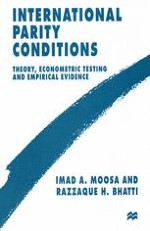1997 | OriginalPaper | Buchkapitel
Uncovered Interest Parity and the Efficient Market Hypothesis: The Empirical Evidence
verfasst von : Imad A. Moosa, Razzaque H. Bhatti
Erschienen in: International Parity Conditions
Verlag: Palgrave Macmillan UK
Enthalten in: Professional Book Archive
Aktivieren Sie unsere intelligente Suche, um passende Fachinhalte oder Patente zu finden.
Wählen Sie Textabschnitte aus um mit Künstlicher Intelligenz passenden Patente zu finden. powered by
Markieren Sie Textabschnitte, um KI-gestützt weitere passende Inhalte zu finden. powered by
Empirical work on UIP can be divided into three strands. The first is concerned with testing UIP in order to examine the extent of integration between financial markets (foreign exchange and capital markets) across countries. This is considered to be a direct test because the actual relationship representing UIP is tested by using data on both interest rates and spot exchange rates. The second strand pertains to testing UIP by examining linkages between nominal interest rates across countries. This may be considered as an indirect test because it relies on the maintained hypothesis that the expected rate of change of the spot exchange rate and the risk premium are stationary. The third strand focuses on testing UIP indirectly by using data on exchange rates only in order to find out whether or not unbiased efficiency holds. Testing unbiased efficiency can be viewed as an indirect test of UIP because it relies on the maintained hypothesis of CIP. In the following sections we present an overview of investigative work carried out in the three strands.
